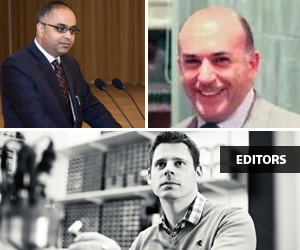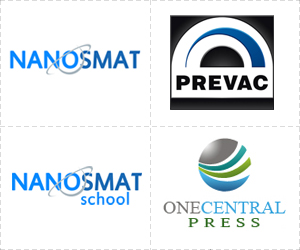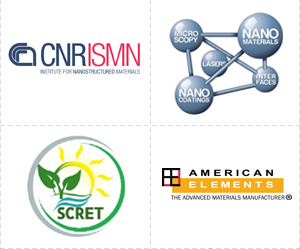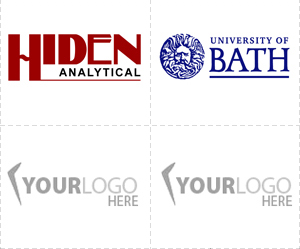Dr Nasar Ali, Founder & Chairman NANOSMAT
Interview with Dr Nasar Ali, Founder & Chairman NANOSMAT
Dr Nasar Ali is the founder & chairman of NANOSMAT and a Visiting Professor at Meliksah University in Kayseri, Turkey. He has held the post of a chief scientific officer at CNC Coatings Company based in Rochdale, UK. Prior to this, Dr Ali was a faculty member at the University of Aveiro in Portugal, where he founded and led the Surface Engineering and Nanotechnology Group. Dr Ali has extensive research experience in hard carbon-coating materials, including nano-sized diamond coatings and carbon nanotubes deposited using CVD technologies. He has over 120 international peer reviewed research publications, including a number of book chapters. He served for 2 years on invitation as the fellow of the Institute of Nanotechnology. Dr Ali has authored and edited several books on surface coatings, thin films and nanotechnology for leading publishers and was also the founder of the Journal of Nano Research (Trans Tech Publishers). Dr Ali was the recipient of the prestigious Bunshah Prize at ICMCTF-2002 conference in San Diego, USA for his work on developing time modulated CVD.
Here are some of the highlights of his recent interview conducted at the NANOENERGY 2015 conference held in Manchester, UK during 1-3 June 2015.
Could you please tell us a little about yourself and your background in nanotechnology?
My name is Nasar Ali and my background is in Chemistry. I studied for a BSc (Hons) in Chemistry and then went on to study for an MSc in Polymer Engineering and Technology. Subsequently, I went on to study for a PhD in Physical Chemistry – focusing on chemical vapour deposition (CVD) of carbon-based coatings. I was looking at diamond-like carbon (DLC), polycrystalline diamond coatings, nanocrystalline diamond, doing fundamental work, by looking at the growth characteristics and trying to obtain a better understanding of the mechanisms of deposition. We were applying such materials for different applications, such as biomedical, cutting tools, etc. We looked at various applications of nanocrystalline diamond, for instance in hip prostheses, artificial heart valves, dental burrs and surgical tools. Surface engineering is diverse multidisciplinary field. We also looked at the synthesis of carbon nanotubes as a natural progression from diamond coatings. We developed a new time-modulated CVD process, which gave us independent control of the deposition process and control of the morphology of carbon-based coatings. My background is in surface coatings and in particular in carbon-based coatings. I have published widely in peer reviewed materials journals and presented my work at international conferences worldwide.
You attended several international conferences during your PhD, what did you make of your experiences and how are NANOSMAT series of conferences distinct from those conferences you attended such as ICMCTF and “Diamond” Conference?
Yes. I was fortunate to travel around the world attending major international conferences in my field during my PhD years. I gave many talks and presented my work at established scientific forums, such as at ICMCTF (USA), Diamond Conference (Europe), Surface Engineering Congress (ASM, USA) etc. I was also very passionate about publishing research papers in peer reviewed journals. I managed to publish about 25 research papers by the time I completed my PhD in Journals such as Diamond and Related Materials, Thin Solid Films, Journal of Materials Research etc. Being an ambitious person and coming from a family of honest and hardworking people I set myself a task of reaching 3 figures in publications within the next 5 years. During my very productive time in Portugal at the University of Aveiro I was able to reach the 100 paper publications mark with the help of my research group, including students, colleagues and fantastic international collaborators from Italy, UK and USA.
I learned a lot from my experiences of presenting my work in front of an informed audience of international scientists. As well as improving my knowledge in my research field, and building up a good network of scientists working in the coatings field.I was also able to learn about the different components that contributed to the organisation of a successful scientific conference.
The NANOSMAT delegates enjoy a friendly atmosphere and the welcome they feel at NANOSMAT events. A good number of people have been attending NANOSMAT each year, since the inception of NANOSMAT in 2005. I believe there is a force of attraction that is keeping these people together as one NANOSMAT community or family, which is gradually growing in size and will continue to grow.
One of the other reasons of NANOSMAT’s success has been partly due to my extended and strong international network of scientists. I remember when I was preparing for the literature review chapter of my PhD thesis, I used to email senior scientists for copies of their research papers (as our university was not subscribed to ScienceDirect at the time). They would kindly email me their papers in PDF format and then when I got involved with NANOSMAT – these same people were attending our conferences. For example, Dr Dieter Gruen (Argonne National Laboratories, USA), Professor Kroto (Nobel Laureate), Professor Bill Milne (Cambridge University, UK), etc. just to name a few. I have constantly enjoyed the support of senior professors, such as Professor Jeff De-Hosson from Netherlands, Professor Stanislaw Mitura (Poland), Professor Jean Ebothe (France), Dr Giuseppe Fierro (Italy), Professor Waqar Ahmed (UK), Professor Mircea Chipara (USA) etc. in my endeavours. I think a strong science focus and a welcoming family atmosphere are key aspects that have made NANOSMAT grow in quality during the last 10 years.
You founded the successful NANOSMAT series of conferences.When was the first conference held and what was the basic idea behind NANOSMAT? What was your basic philosophy and why have you started these conferences?
The first NANOSMAT was held in 2005 and the term NANOSMAT was coined in 2004 when I was a faculty member at the University of Aveiro in Portugal. Professor Jose Gracio from Aveiro University, who unfortunately is no longer with us (passed away in 2014 with cancer), helped me to organise NANOSMAT in 2005. Professor Gracio was a great person, scientist and someone who played a pivotal role in the organisation of the inaugural NANOSMAT in Aveiro during September 2005. The 11th NANOSMAT will be held in 2016 in Aveiro, Portugal in special memory of Professor Gracio who was the head of Mechanical Engineering Department and Director of the “Centre for Mechanical Technology and Automation”. We wanted to bring together scientists and engineers working on coatings, surfaces and materials science, engineering and technology. It began as a materials-type conference and then it developed into a nanoscience and nanotechnology conference, employing nanomaterials and looking at their applications. We also included commercial aspects of nanoscience and nanotechnology with more companies entering the nanotechnology field bringing new applications to the market. The 10th NANOSMAT will be held in September this year (2015) in Manchester, UK. We will be celebrating 10 years of successful organisation of NANOSMAT conferences all over the world. We have attracted a number of Nobel Laureatesto our events and they havedelivered plenary lectures and have included Professor Sir Harold Kroto, Professor Jean Marie-Lehn, Professor Peter Grunberg, Professor Albert Fert and Professor Andrei Geim. Other key people have been highly recognised international invited speakers. Recently, we have branched out into NanoEnergy and NanoMedicine conferences, which have attracted many speakers requiring further specialisation. We are fortunate to have Professor Sir David King FRS opening our next NanoEnergy 2016 conference to be held in Liverpool University, UK.
NANOSMAT has been able to reach out to the wider international scientific committee. It attracted delegates from about 50 countries round the world. This is great since this gives people, especially from third world countries, the opportunity to interact with best scientists in the world in order to improve knowledge and to start up work on new projects and scientific collaborations.
You also have Professor Sir Andrei Geim attending and opening the 10th NANOSMAT conference. What was the idea behind getting him to open the conference?
With the NANOSMAT conference series, it has become a tradition to have a Nobel Laureate give the plenary lecture. Since the 10th NANOSMAT is being held in Manchester, Professor Sir Andrei Geim, from the University of Manchester kindly accepted our invitation to give the plenary lecture during the 10th NANOSMAT. Manchester also houses the Graphene Centre, hence Professor Sir Geim will be speaking at the event about his ground breaking work on graphene, which won him the Nobel Prize in Physics in 2010. We are expecting to attract a lot of scientist from all over the world.
There is also the highly prestigious NANOSMAT Prize. What was the idea behind the prize? I know highly prestigious people have won it so far. Can you tell us a bit about the prize?
NANOSMAT Prize came about in 2009 and the idea was to recognise excellent scientistswho have achieved and contributed significantly to the field of Nanoscience and Nanotechnology. We have had a lot of interest and high calibre scientists have nominated excellent peoplefor this prize and as time went on, it has become more popular. We came to the point where we were getting some excellent and outstanding young(er) scientists who were applying for the NANOSMAT Prize as well asoutstanding senior scientists.The awards committee decided that it wasn’t fair that some of the senior scientists, who have been doing the work for a lot of longer, were competing with people who were in their early 40s, in the middle of their academic careers. We came out with the NANOSMAT Outstanding Young Scientist Award (OYSA) to even things out. The first OYSA was awarded to Professor Stephan Link from Rice University (USA) during the 9th NANOSMAT-2014 held at Trinity College Dublin in Ireland. The OYSA 2015 will be awarded to Professor Zeev Zalevsky from Bar-Ilan University, Israel. We are trying to recognise senior as well the younger scientist who have contributed significantly to the broad field of nanotechnology.
How is the OYSA different from NANOSMAT Prize? What are you trying to emphasise?
They are similar in the sense that in both cases we want to recognise excellence. As I mentioned earlier we started off with one prize called the NANOSMAT PRIZE which attracted many high calibre scientists. What we observed was that nominated candidates competing for this prize were all at different stages of their professional careers at the time of applying. Therefore, the NANOSMAT Awards committee decided in order to make the competition more balanced we must separate senior scientists (between 46-65 years of age) from the younger scientists (up to 45 years of age) when considering them for this award. However, the criteria for selecting the successful candidatewas kept the same.This included high quality research, leadership, research funding, publications, honours, innovation.
At NANOSMAT 2015 you are introducing the Prize for best presentation for research students such as those doing PhDs, what is the major purpose and focus of this prize?
We host each year a ‘Young Scientist Lecture Competition’ during the NANOSMAT conferences. This competition started in 2010 during the NANOSMAT meeting, which was held in Reims in France. The Young Scientist Lecture Competition has gained popularity and prestige. The aim is to provide a friendly atmosphere competition for young scientists working in the fields of Nanoscience and Nanotechnology so that their presentation skills will improve whilst addressing an informed audience. It is important for younger scientists to be able to present their work articulately in an exciting and clear manner. This prize is an incentive to younger scientists to develop their presentation skills in a competitive environment.
You also host an exhibition at NANOSMAT meetings – tell us a bit about this.
Each year we host an exhibition as part of the NANOSMAT conference. We have had large number of companies from around the world who have exhibited at the NANOSMAT forum in order to showcase their products and services that relate to the theme of the conference.We have had companies from USA, Europe and Asia who have exhibited and/or sponsored one of the NANOSMAT organised events. Itis important for scientists to liaise closely with companies and vice versa to bring the science to the wider international community.
There is also an idea of developing a Journal. Can you tell us a bit about this journal and give us an insight into the future?
We have been producing a lot of special issues of high impact journals for major publisherssuch as Elsevier, Wiley etc. We have been thinking and planning to start a new journal on functional nanostructured materials to give a platform for the NANOSMAT scientific community to publish their work in a reputed international peer reviewed journal. We have been doing a lot of work in the background so we have come to a point where the new journal should be launched during late 2015. The emphasis will be on high quality impactful research. The journal will cover topics of nanomaterials, functional nanomaterials and the applications of nanotechnology. We have appointed a set of eminent Editors-in-Chief with a distinguished editorial board. The topics have been set. The launch will happen during late 2015.
Where do you think the most important discoveries in nanotechnology are going to be in the next 5 to 10 years?
Although nanotechnology has a lot of applications, I think the best applications would be where the technology improves the lifetime and the quality of people’s lives. For example, in the medical field, Professor Seifalian from University College London, UK has developed a novel polymer-based nanocomposite material, which was used to form a trachea and with the patients stem cell seeding in this trachea – it was implanted in a human, which saved the patient’s life. So you can see the work that has been done in the lab scale has actually helped to save a life of a human being. I think these are very, very important application areas. Furthermore, energy and medicine are also important areas where nanotechnology can benefit such fields. Furthermore, nanotechnology will help save lives by ‘water treatment’ since many people in the third world countries die due to drinking contaminated water.
A decade of huge success is a major achievement, how do you see NANOSMAT developing over the next decade?
Yes, it’s been constant hard work for 10 years in organising these conferences all around the world. Also its very hard work after the conference when the guest editors, consisting of members from the core NANOSMAT steering committee, edit papers from the conferences in producing special issues of peer reviewed journals. Elsevier and Wiley have expressed great interest and have worked with us and our team of guest editors in producing excellent special issues of their journals each year.
For the near future, since we already have running NANOSMAT-USA, NANOSMAT-Asia and NANOSMAT-Europe meetings, we are looking to continue with the momentum and to start NANOSMAT-Africa and NANOSMAT-Middle East etc. However, there are a lot of discussions that need to take place and we will need the support from key people from these regions before such new congresses are officially launched.
If you were to give one message to Nanoscience and Nanotechnology community what message would that be?
The message would be to carry on with your efforts in trying to make new breakthroughs in research and development in order to make the world we live in a better and safer place. We want to encourage, support research and development in important areas. I would encourage and request to the governments of different countries to fund and invest in nanotechnology research so that the scientists can work together to overcome some of the key challenges faced by the human race in order to make the world we live in a better and safer environment. For younger scientists I would emphasise the importance of building a solid foundation in the field and NANOSMAT provides an opportunity for them to interact with world leading scientists in the field.






